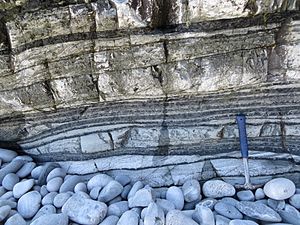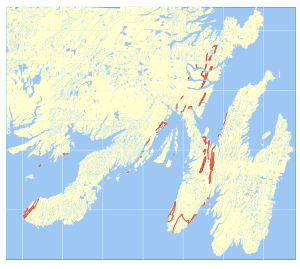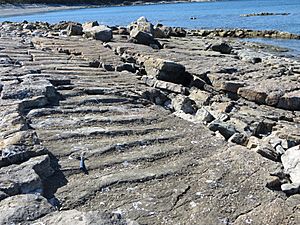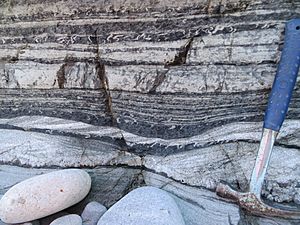Random Formation facts for kids
Quick facts for kids Random FormationStratigraphic range: Early Cambrian |
|
|---|---|

Some facies of the Random Formation: Synaresis cracks in mudstones, with overlying white cross-bedded tidal sandstones
|
|
| Type | Formation |
| Unit of | Young's Cove Group, Musgravetown Group, or none, depending on authority (and location) |
| Underlies | (Unconformably) Bonavista Fm and others |
| Overlies |
|
| Thickness | From a few metres to 250 m |
| Lithology | |
| Primary | Herringbone-crossstratified white arenites |
| Other | Grey-green silts and shales |
| Location | |
| Region | |
| Country | |
| Type section | |
| Named for | Random Island |
 Bedrock distribution of the Random Formation |
|
The Random Formation is a special type of rock layer found in Newfoundland, Canada. It formed a very long time ago, during the Cambrian period. This was a time when life on Earth was just starting to become more complex.
This rock unit is mostly made of white sandstones that were laid down by tides near an ancient coastline. It also has mudstones, which are now shales, and red sandstones from old river channels. The Random Formation formed quite quickly and can be up to 250 meters (about 820 feet) thick. Another rock layer, called the Blue Pinion Formation, is now thought to be part of the Random Formation.
Contents
What are the Random Formation rocks like?
The white sandstones in the Random Formation are very easy to spot. They have a special pattern called herringbone cross-stratification. This pattern shows that the sand was moved by strong currents, possibly from storms.
Mixed in with these sandstones are green-grey sands and silts. These layers tell us that the area was sometimes covered by water and sometimes exposed, like a muddy beach at low tide.
Where can you find the Random Formation?
Unlike some older rock layers, the Random Formation is found in many places across Newfoundland. It formed in different environments, from muddy areas that were exposed at low tide to deeper parts of the ocean shelf.
The very top of this rock unit gradually blends into the layers of rock that formed above it.
How old is the Random Formation?
It can be tricky to figure out the exact age of the Random Formation. Scientists believe it formed during the late Precambrian and early Cambrian periods. It lies below the Bonavista Formation and above even older rocks from the Ediacaran period.
On the Burin Peninsula, the Random Formation sits above the Chapel Island Formation. This means that in that area, the lower part of the Random Formation is from the early Cambrian period. Tiny shell fossils found in the upper parts of the Random Formation suggest those layers are from the late early Cambrian or even early middle Cambrian.
It's likely that different parts of the Random Formation formed at slightly different times. This means some parts might be older, dating back to the Ediacaran period further east.
Scientists have also looked for the boundary between two early Cambrian stages, called Tommotian and Atdabanian. This boundary might be within the Random Formation or in the Bonavista Formation above it. The first signs of trilobites, ancient sea creatures, appear in the Smith Point Formation, which is found above the Random Formation.
What fossils are found in the Random Formation?
Even though it's very old, the Random Formation contains some interesting trace fossils. These are not the actual bodies of creatures, but rather the marks they left behind. You can find:
- Rusophycus and Cruziana: These look like scratches or grooves and were made by trilobite-like creatures moving or resting on the seafloor.
- Other trace fossils like Diplocraterion, Paleodictyon, Scolicia, and Squamodictyon.
Besides trace fossils, some very small body fossils have been found. These are part of what scientists call the Aldanella attleborensis group of small shelly fauna. These are tiny shells and other hard parts from some of the earliest animals.



